How to clean a dishwasher at home: the best mechanical and chemical methods
In order for the dishwasher to cope with its duties, it is necessary not only to follow the rules of operation, but also to regularly look after the equipment. Otherwise, you may encounter such troubles as the smell of musty, fatty deposits, mold. And in especially neglected cases - and with a breakdown of the equipment itself.
You will learn all about how to clean the dishwasher at home and extend its service life from the article we have proposed. We have described in detail the methods and steps for caring for the dishwasher, and listed the means tested in practice. Given our advice, you will eliminate any problems in the operation of the machine.
The content of the article:
Mechanical Cleaning Steps
Although many modern models of dishwashers have a self-cleaning function, this does not save you from the need to periodically wash filters and other elements of the machine.
And even professional tools for caring for the device may not be enough when it comes to blockages or operation in hard water. Therefore, the key to the perfect operation of the dishwasher is a comprehensive and timely care.
Flushing the drain and filler filter
On the drain of any dishwasher there is a multilayer filter, the task of which is to prevent blockage of the drain with food pieces and other garbage.
But even if you diligently follow the manufacturer’s recommendations and wipe the dishes with napkins before each load, to remove food residues, stopping the appliance that has not completed the full washing cyclemay become greasy or plaque from hard water.
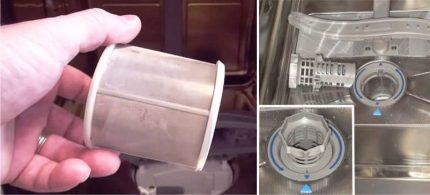
To get to the filter, proceed as follows:
- Turn off the dishwasher.
- We remove the lower basket, collect the remaining water at the bottom of the device with a sponge.
- In the lower part of the body next to the sprayer we find a round recess - it contains a filter, which consists of a metal membrane for fine cleaning, a plastic cup with large holes and an internal mesh.
- In new dishwashers, for this element an easy removal is provided - just pull up or unscrew counterclockwise. But in models older than 7-10 years, you may need a screwdriver, pliers and other improvised tools from the arsenal of the home master.
- From the hole under the filter, you need to remove water with a sponge and inspect the niche for contaminants - if any solid particles of waste get through the filter guard, they can damage or break the pump.
- To make sure that the impeller of the pump is working, you can unscrew the screw with a screwdriver, remove the protective strip and carefully turn the blades. If they rotate easily and no foreign objects are found, you can collect them back. Otherwise, you will have to disassemble the design of the pump.
- Then all parts are cleaned of accumulated debris and washed with warm water with any fat-dissolving agent. If the filter has not been cleaned for a long time, the mesh cells are badly clogged or the glass is scaled, you can soak these elements for a couple of hours in a solution of vinegar, citric acid or sprinkle with dishwashing detergent.
Although the outlet filter is the most popular place for accumulation of blockages, with complex mechanical cleaning of the dishwasher, it does not interfere with checking the condition of the intake hose. There may be accumulations of sand, particles of rust and salts.
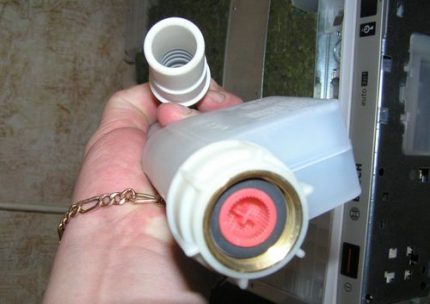
To clean the bay of the dishwasher, disconnect the inlet hose (and at the same time rinse it). There should be two filters inside: just behind the tee tap and at the entrance to the device itself.
Both nets are removed and washed with warm water. If they are damaged or badly clogged, you can replace them with new ones - such consumables are inexpensive. After checking, all filters are collected in the reverse order.
Checking and cleaning sprinklers
Another problematic element that can disable dishwasher - spray system. Although the water from the hose is already cleaned of large impurities, small particles of sand and calcium salt easily pass through the cells of the inlet filter.
In addition, water with high rigidity can damage the sealing gum on the rotating rocker arms, so it is advisable to inspect their condition at least 1 time per month.

The principle of cleaning sprayers:
- Take out the upper basket with the beam attached to it.
- Bend latches and remove sprayer blades.
- Take out the lower basket and remove the lower beam - usually, just turn the beam counterclockwise and pull it up while holding the part in the middle.
- Inspect the condition of the seals (replace if necessary).
- Rinse the blades under running water, clean the nozzles and connectors.
- Reassemble the system and make sure that the sprinklers rotate without interference and effort.
The rocker arms of the different models may vary, so you should check the instructions before the first cleaning, so as not to accidentally break the latches.
How to clean the nozzles on the spray nozzles of a Hansa dishwasher, the video demonstrates:
Cleaning the housing and gaskets
It is recommended to wipe the inner walls, baskets and rubber on the appliance door after each start. But it does not hurt to periodically disinfect these areas with the help of a special tool that is approved for use in dishwashers.
Particular attention should be paid to the joints and the area on the bottom of the door - they are almost not washed with water during washing, so food debris quickly accumulates and begins to decompose.
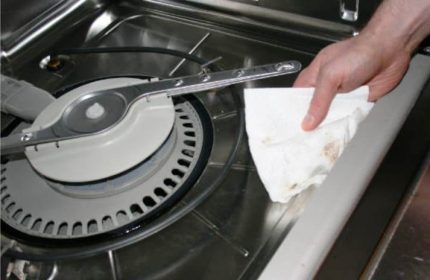
It is enough to wipe a not so dirty sealant with a soft cloth soaked in a cleaning solution, and in advanced cases you can help yourself with a toothbrush. But spraying the product or washing the door with a wet sponge is undesirable so that the liquid does not get into the wiring or into the lock.
Many housewives use household products to clean household appliances, for example, the same lemon powder or vinegar. But in the case of gaskets, such a saving is very doubtful - the gum may harden or dry out under the influence of acid, and the machine will begin to leak during operation.
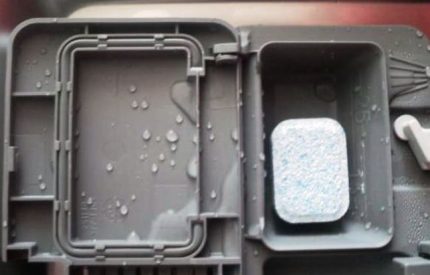
Baskets with dried food debris can first be soaked in warm water for a couple of hours, then washed in a soapy solution with a stiff non-metallic brush. However, the self-cleaning function also copes with this task well, if it is provided in the device. Before installation inside the box, all elements must be washed with clean running water and wiped dry.
Eliminate grease, mold and scale
If you notice that on the dishes or the inner walls of the appliance appeared whitish coating or an unpleasant smell began to be heard from the box - an urgent need to start cleaning the car.
And the best helpers here will be ready-made solutions made by machine manufacturers. Handy tools that are likely to be found in the kitchen of any housewife are also useful.
The use of finished chemicals
To wash the dishwasher and its internal elements that are not accessible to simple mechanical cleaning, it is recommended to start the appliance on any long cycle at high temperature with cleaning agent.
But if you notice yellow or rusty spots on the inside of the dishwasher, the high iron content in the water may also be the cause. In this case, you will have to install a special filter on the inlet hose.
Fresh stains can be removed with a rag soaked in stainless steel cleaner, but old rust after washing is best treated with an anti-corrosion coating.
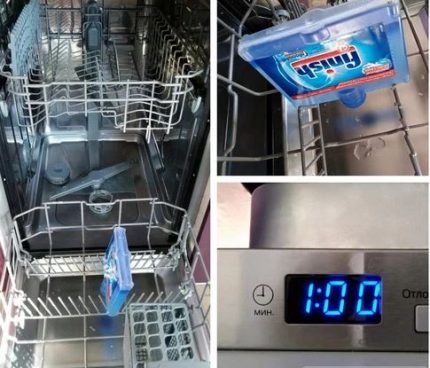
The most popular chemicals for disinfection and descaling:
- Finish machine cleaner - under the influence of hot water, the membrane on the neck of the bottle dissolves, and the product actively cleans all accessible surfaces from grease, scale and unpleasant odors.
- Decalcifier - degreasing powder to remove limescale and scale on the internal elements of the machine.
- Filtero - liquid for preventive cleaning of dishwashers from grease and scale.
- ELECTROLUX - liquid agent for removing fatty deposits and small food debris, as well as anti-scale powder and flavoring.
These drugs work on a similar principle - they are placed in an empty dishwasher, then turn on the device for 45-90 minutes at high temperature. After that, it is recommended to run the washing again once, already for a short cycle, to guarantee that all chemical residues are removed and wipe the surfaces dry with a soft cloth.
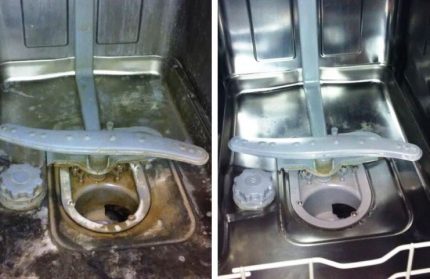
In addition, you can use specialized sprays and liquids recommended for cleaning and polishing stainless walls of the dishwasher, and to combat unpleasant odors - fragrances that are suspended on the basket of the device and can be used for several cycles.
But manufacturers do not recommend adding dishwashing liquid for preventive washing and degreasing the surface.
The fact is that increased foaming can damage the internal elements of the device, and attempts to save will result in repairs. Therefore, you can and should manually wipe the surfaces in a soap solution, but you should not start the machine with the addition of foaming liquid.
Alternative to Purchased Goods
Professional preparations are good for their balanced composition and complex effect on the three most common problems of machines - scale, smell and fatty deposits. But if you are looking for a way to quickly clean a dishwasher while saving money, we offer several recipes from inexpensive but effective ingredients.
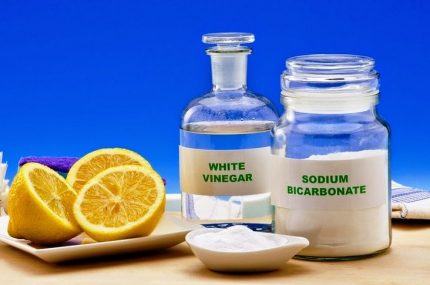
To clean the machine, and at the same time drain from fat deposits, you need to pour 1.5-2 cups of vinegar into a cup or plate. Then they should be placed in the upper tray, pour soda on the bottom and start any long-term mode.
And as soon as the water heats up - press the pause and leave the device for at least 30 minutes (but preferably at night). During this time, various dried garbage and plaque will soften and easily be removed along with dirty water.
Another universal tool that will help remove traces of scale is citric acid. Its consumption depends on the displacement of the machine and the degree of pollution, but on average it will take about 150-200 grams. It also works at high temperatures, and for the best effect - with a forced stop of the device from 30 minutes to several hours.

There is also a more gentle way - to prepare a solution of water and vinegar or lemon powder, pour it into any spray bottle and use it to manually clean the inner walls of the box and other scum surfaces. In this case, you need to spray the product gently and make sure that it does not get on the rubber elements, as well as on the skin.
From soda, you can make 2 in 1 tablets, which will not only help clean the machine of grease and dirt, but also refresh the air with a pleasant aroma.
Cooking method:
- Pour 10-15 drops of any essential oil and 1-2 tablespoons of hydrogen peroxide into a glass with powder soda.
- Shuffle everything with a spatula - the mixture should look like wet sand.
- Using a spoon or ice cream scoop, stick small balls.
- Arrange the prepared tablets at the bottom of the appliance.
- Run the dishwasher for a long cycle.
For the best effect, users recommend placing in a basket also a plate with 1-2 glasses of vinegar.
Care and maintenance tips
Comprehensive cleaning of the machine is recommended at least 1 time per month, and flushing the filtration system - weekly.
But to reduce the amount of work during the general cleaning, we recommend taking a few simple tips on regular maintenance and operation:
- Place dishes in trays according to the layout of the manufacturer. General recommendationsHowever, they are the same for all appliances - pans, pans, baking trays and other heavily soiled or coarse dishes are always placed below - there the washing is more active. And glasses, cups and deep plates are always turned upside down so that no powder and water remains in them.
- Before loading, wipe dishes from large debris with an ordinary cloth.
- Use regenerating salt in addition to detergent powder or tablets that already contain a softener.
- After each cycle, remove the coarse filter screen and remove any accumulated debris.
- Check the compartment for detergentsso that no powder or pieces of tablets remain in it.
Use only non-metallic objects and soft rags for cleaning - hard fibers can damage the protective coating of the box or baskets and give a “green light” to rust.
The video will familiarize you with the features of cleaning the dishwasher with home remedies and with the preparation method:
To avoid the appearance of a musty odor, always wipe the internal components after each start-up with a dry cloth and ventilate the appliance until the condensation evaporates.
And the last tip - use the dishwasher at least 3-4 times a week. Paradoxical as it may seem, the longer the device is left without work, the shorter its service life will be, since with such downtime problems with blockages, limestone and unpleasant odors more often arise.
Conclusions and useful video on the topic
In order to visualize the volume of the upcoming cleaning, the features of extracting and cleaning the internal elements of the dishwasher, we suggest that you familiarize yourself with a small selection of video tips from home masters and experienced housewives.
Regular maintenance and preventive flushing of the dishwasher systems:
As you can see, there is nothing complicated in caring for dishwasher equipment. But if the machine is not pampered with regular cleaning, its sparkling walls will quickly become covered with a coating.
Food waste will clog the filters and nozzles of the nozzles, a fungus will settle in the seal, and key parts will fail and require replacement. Do not forget about your assistant or entrust her prevention to cleaning specialists.
Want to talk about how and with what means you care for your own dishwasher? Do you have a unique technique or interesting information that is worth sharing with site visitors? Please write comments in the block below, ask questions about the topic of the article.

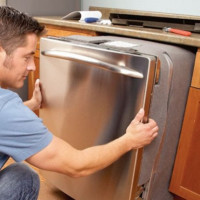 Installing the facade on the dishwasher: tips + installation instructions
Installing the facade on the dishwasher: tips + installation instructions 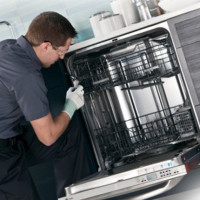 How to integrate a dishwasher into a finished kitchen: installation options + work procedure
How to integrate a dishwasher into a finished kitchen: installation options + work procedure 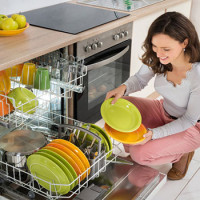 How to load dishes in the dishwasher: the rules of operation of the dishwasher
How to load dishes in the dishwasher: the rules of operation of the dishwasher 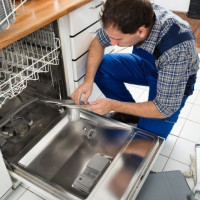 Repair of dishwashers Electrolux at home: typical malfunctions and their elimination
Repair of dishwashers Electrolux at home: typical malfunctions and their elimination 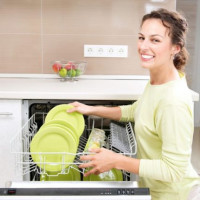 How to choose a dishwasher: selection criteria + expert advice
How to choose a dishwasher: selection criteria + expert advice 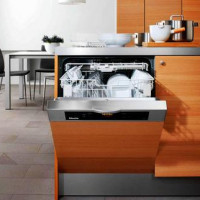 How to choose a built-in dishwasher: what to look for when buying + an overview of the best brands
How to choose a built-in dishwasher: what to look for when buying + an overview of the best brands  How much does it cost to connect gas to a private house: the price of organizing gas supply
How much does it cost to connect gas to a private house: the price of organizing gas supply  The best washing machines with dryer: model rating and customer tips
The best washing machines with dryer: model rating and customer tips  What is the color temperature of light and the nuances of choosing the temperature of the lamps to suit your needs
What is the color temperature of light and the nuances of choosing the temperature of the lamps to suit your needs  Replacement of a geyser in an apartment: replacement paperwork + basic norms and requirements
Replacement of a geyser in an apartment: replacement paperwork + basic norms and requirements
How can I clear a blockage in the PMM Siemens SF64T354EU?
Fat deposits are few. You can clean it as follows: type warm (not hot!) Water into the bath and place the sidewall from the dishwasher there. Pour in water ½ cup dishwashing detergents such as "Fairy", "Sort", "Pemolux" and leave for 15 minutes. The fat softens and can be removed with a sponge or toothbrush. Do not use abrasive, acid-containing or chlorine-containing products, as well as metal brushes. Then rinse with clean water and dry at room temperature. It is important that the foam tabs and plastic dry out well, otherwise mold will appear.
I have a problem with the dishwasher - it smells very damp, or something so unpleasant, reminiscent of damp. After trying to clean with salt, nothing has changed. Maybe I don't keep it open enough after work? It got to the point that some kind of plaque forms at the bottom.How can I clean a dishwasher in my case? Is it mandatory to remove and clean the filters? I'm afraid to take it apart.
Hello Diana! Unpleasant odor in PMM is formed for the following reasons:
1) high humidity and room temperature;
2) lack of ventilation in the room;
3) leaving in the car wet dishes;
4) clogging of the drain filter, hoses or nozzles;
5) stagnation of water in the lower part of the hopper;
6) wear of the rubber door cuff;
7) improper connection to the sewer - dirty water enters the drain hose.
—————–
To get rid of the smell I recommend doing the following:
1. Make sure that there is no water in the pan of the dishwasher. To do this, tilt the machine forward by 45 degrees and hold in this position for 30-60 seconds.
2. Use a special cleaning agent that removes blockages and mold. You can learn more about such tools and the rules for their use in this article.
3. Leave the dishwasher open for 12-24 hours, creating good conditions in the room for ventilation (open the window, turn on the forced ventilation).
As a rule, after these manipulations, the smell of mold disappears. If the cause of the smell is the accumulation of mold in the worn part, it is best to replace it. To prevent unpleasant odors, operate the PMM correctly, clean the filters regularly, and use a cleaning agent. To eliminate the smell of powder help special flavors for dishwashers, which are glued to the wall or hung on a basket.
Friends left and left the PMM Electrolux, almost new. I found the instructions on the internet. All that can be washed and cleaned, but when turned on, it immediately starts working (it feels like a pump), although I did not ask any programs. When you turn on the programs, nothing changes, the PMM does not work.
Hello. Perhaps triggered by Aquastop. You need to drain the water from the pan and look, maybe there are somewhere leaks in the connection system.